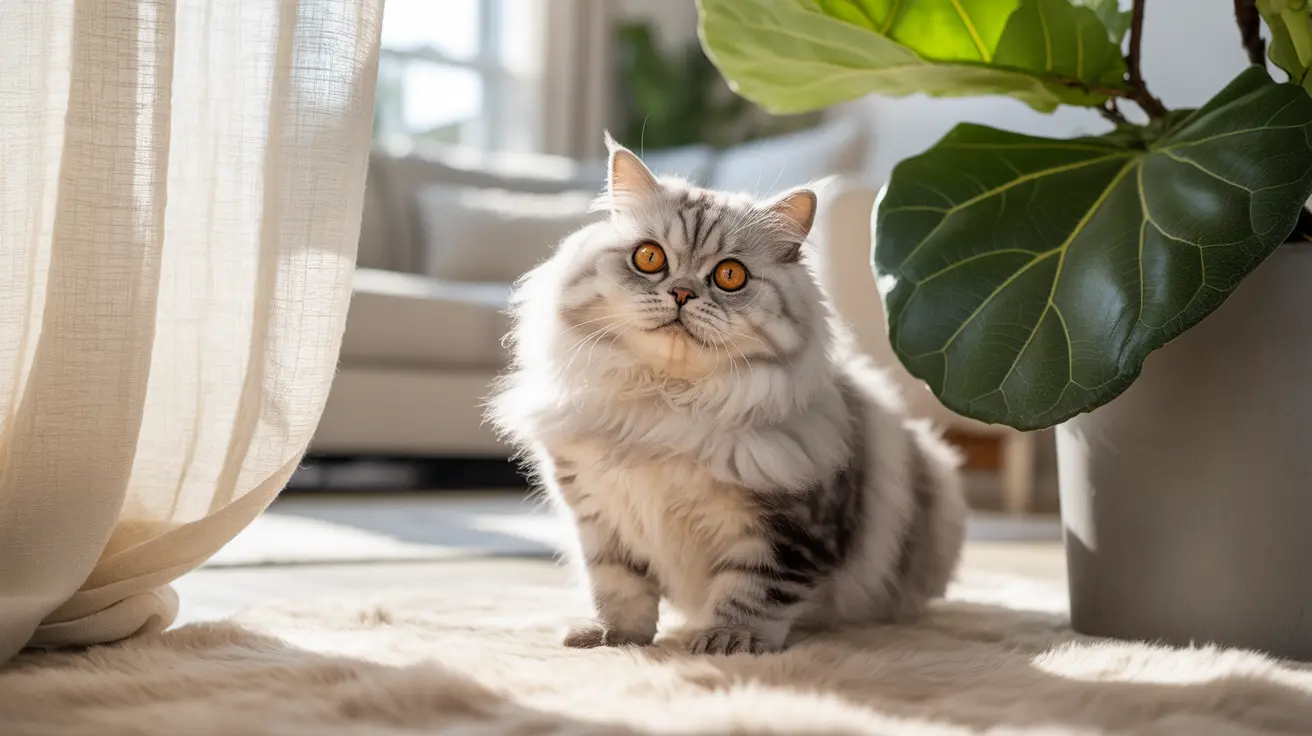Understanding Fiddle Leaf Fig Toxicity
Fiddle leaf figs contain insoluble calcium oxalate crystals in their leaves, stems, and sap. These microscopic crystals are the plant's natural defense mechanism, and they're what makes the plant toxic to cats. When a cat bites into any part of the plant, these sharp crystals immediately begin causing irritation and damage to the sensitive tissues in their mouth and digestive tract.
Additionally, the plant produces a milky white sap that can cause further irritation, both internally if ingested and externally if it comes into contact with your cat's skin or fur.
Signs of Fiddle Leaf Fig Poisoning in Cats
If your cat has encountered a fiddle leaf fig, watch for these common symptoms:
- Immediate oral pain and irritation
- Excessive drooling or foaming at the mouth
- Pawing at the mouth or face
- Difficulty swallowing
- Vomiting or retching
- Decreased appetite
- Lethargy or weakness
- Skin irritation or rashes (if contact with sap occurs)
Emergency Response and Treatment
If you suspect your cat has ingested any part of a fiddle leaf fig, take these immediate steps:
- Remove any plant material from your cat's mouth if possible
- Rinse their mouth with water to help remove crystal residue
- Contact your veterinarian or animal poison control immediately
- Monitor your cat closely for worsening symptoms
Most cases of fiddle leaf fig toxicity can be managed with supportive care, including anti-nausea medication and fluid therapy if needed. While severe cases are rare, prompt veterinary attention ensures the best outcome for your pet.
Prevention and Safe Alternatives
The best way to protect your cat from fiddle leaf fig toxicity is through prevention. Consider these safety measures:
- Place fiddle leaf figs in rooms your cat cannot access
- Use hanging planters or tall plant stands out of jumping reach
- Create physical barriers around the plant
- Consider replacing the plant with cat-safe alternatives like spider plants, Boston ferns, or parlor palms
Frequently Asked Questions
What symptoms should I watch for if my cat ingests part of a fiddle leaf fig plant?
Watch for immediate signs like drooling, oral pain, pawing at the mouth, vomiting, and difficulty swallowing. In some cases, you may also notice decreased appetite, lethargy, and gastrointestinal upset.
How does fiddle leaf fig toxicity affect cats and is it fatal?
While fiddle leaf fig toxicity can cause significant discomfort, it's rarely fatal. The calcium oxalate crystals cause localized irritation and inflammation, but with proper veterinary care, most cats recover fully within 24-48 hours.
What immediate steps should I take if my cat chews on a fiddle leaf fig?
First, remove any plant material from your cat's mouth, rinse their mouth with water if possible, and contact your veterinarian immediately. Do not induce vomiting unless specifically instructed by a veterinary professional.
Can fiddle leaf fig sap cause skin irritation in cats and how can I prevent it?
Yes, the sap can cause skin irritation and dermatitis in cats. Prevent exposure by keeping cats away from the plant, especially when pruning or if branches are damaged. Clean up any sap immediately if branches break.
Are there safer houseplant alternatives for homes with cats instead of fiddle leaf figs?
Yes, many attractive houseplants are safe for cats, including spider plants, Boston ferns, parlor palms, African violets, and Swedish ivy. Always verify plant safety through the ASPCA's toxic plant database before bringing new plants into your home.
Conclusion
While fiddle leaf figs are beautiful houseplants, their toxicity to cats means pet owners must exercise caution. By understanding the risks, recognizing symptoms quickly, and taking appropriate preventive measures, you can create a safe environment for both your plants and your feline companions. When in doubt, always prioritize your pet's safety and consider switching to cat-friendly alternatives.






